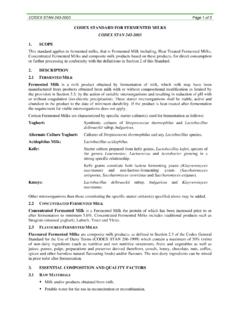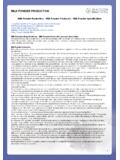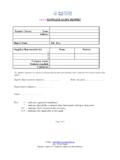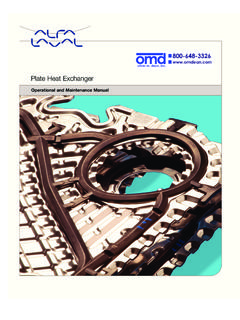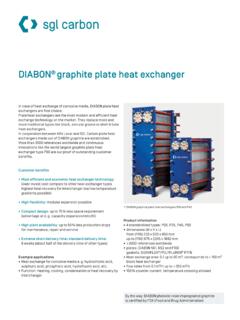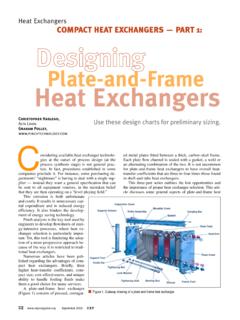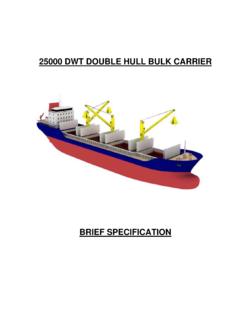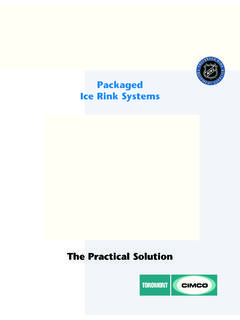Transcription of For the attention of Asif Sahib - Dairy Consultant
1 Calculation method. The five most important parameters are as follows: The amount of heat to be transferred ( heat load/capacity) (unit kW). The inlet and outlet temperatures on the primary and secondary sides The maximum allowable pressure drop on the primary and secondary sides. The maximum operating temperature. The maximum operating pressureIf the flow rate, specific heat and temperature difference on one side are known, the heat load can be profileThis means the inlet and outlet temperatures of both media in the heat = Inlet temperature, hot sideT2 = Outlet temperature, hot sideT3 = Inlet temperature, cold sideT4 = Outlet temperature, cold sideHeat loadDisregarding heat losses to the atmosphere, which are negligible, the heat lost ( heat load) by one side of a plate heat exchanger is equal to the heat gained by the other. The heat load (P) is expressed in kW or Mean Temperature Difference Logarithmic mean temperature difference (LMTD) is the effective driving force in the heat exchanger.
2 See diagramThermal lengthThermal length ( ) is the relationship between the temperature difference dt on one side and LMTD. = t LMTDD ensityDensity ( ) is the mass per unit volume and is expressed in kg/m or kg/dm ViscosityViscosity is a measure of the ease of flow of a liquid. The lower the viscosity, the more easily it is expressed in centipoise (cP) or centistokes (cSt).Overall heat transfer coefficientOverall heat transfer coefficient (k) is a measure of the resistance to heat flow, made up of the resistances caused by the plate material, amount of fouling, nature of the fluids and type of exchanger used. Overall heat transfer coefficient is expressed as W/m C or kcal/h,m rateThis can be expressed in two different terms, either by weight or by volume. The units of flow by weight are in kg/s or kg/h, the units of flow by volume in m /h or l/min. To convert units of volume into units of weight, it is necessary to multiply the volume flow by the maximum flow rate usually determines which type of heat exchanger is the appropriate one for a specific purpose.
3 Alfa Laval plate heat exchangers can be used for flow rates from kg/s to 1,000 kg/s. In terms of volume, this equates to m /h to 3,600 m dropPressure drop (Dp) is in direct relationship to the size of the plate heat exchanger. If it is possible to increase the allowable pressure drop, and incidentally accept higher pumping costs, then the heat exchanger will be smaller and less expensive. As a guide, allowable pressure drops between 20 and 100 kPa are accepted as normal for water/water allowance (Rf) can be expressed either as an additional percentage of heat transfer area, or as a fouling factorexpressed in the units m C/W or m h plate heat exchanger is designed with higher turbulence than a shell and tube exchanger and this means a lower fouling allowance for the same duty. One could say that the margin included in a plate heat exchanger is normally less than 10%. Specific heat (cp)Specific heat (cp) is the amount of energy required to raise 1 kg of a substance by one degree centigrade.
4 The specific heat of water at 20 C is kJ/kg C or kcal/kg C. Method of calculationThe heat load of a heat exchanger can be derived from the following two formulas:P = m cp tm = P t = P cp tm cpP = k A LMTDW here:P = heat load (kW)m = Mass flow rate (kg/s)cp = Specific heat (kJ/kg C) t = Temperature difference between inlet and outlet on one side ( C)k = Total overall heat transfer coefficient (W/m C)A = heat transfer area (m )LMTD = Log mean temperature difference = Theta-value = k A LMTD m cp, = t/LMTD, = (k A) / (m cp)T1 = Temperature inlet, hot sideT2 = Temperature outlet, hot sideT3 = Temperature inlet, cold sideT4 = Temperature outlet, cold sideLMTD can be calculated by using the following formula:The total overall heat transfer coefficient k is defined as:1 =1 + 1 +t + Rfk 1 2l Where:a1 = The heat transfer coefficient between the warm medium and the heat transfer surface (W/m C)a2 = The heat transfer coefficient between the heat transfer surface and the cold medium (W/m C)t = The thickness of the heat transfer surface (m)Rf = The fouling factor (m C/W)la = The thermal conductivity of metal (W/m C)Every parameter in the above equation can influence the choice of heat exchanger.
5 The choice of materials does not normally influence the efficiency, only the strength and corrosion properties of the important parameter that can be influenced to reduce the size, and therefore the price, of the heat exchanger is to use the highest possible allowable pressure drop, as well as the LMTDA higher pressure drop will usually result in a smaller heat exchanger. A higher Logarithmic Mean Temperature Difference (LMTD) will also give a smaller unit. With heat recovery, the price of the heat exchanger in relationship to the amount of heat recovered is of great significance, since a profit must be realised to make the project materialsStainless steel AISI 304 ( ) can be used in clean water applications. Higher quality AISI 316 ( ) is also available, for use in hygienic situations and with problem cases, or when the chloride content as shown in the table requires the use of this material. For salt water and brackish water only titanium should be materialMax.
6 Temperature Chloride content60 C80 C120 C130 C = 10 ppm304304304316 = 25 ppm304304316316 = 50 ppm304316316Ti = 80 ppm316316316Ti = 150 ppm316316 TiTi = 300 ppm316 TiTiTi > 300 ppmTiTiTiTi Gasket materialNitrile and EPDMP ressure and temperature limitationsThe maximum operating pressure and temperatures are shown in the table. See product specificationIn a plate heat exchanger, we have the advantages of small temperature differences and plate thicknesses of between and mm. The alpha values are a product of the very high turbulence, and the fouling factors are usually very small. This gives a k-value which under favourable circumstances can be in the order of 8,000 W/m traditional shell and tube heat exchangers, the k-value will be below 2,500 W/m the back button on your browser to return whence you cam

